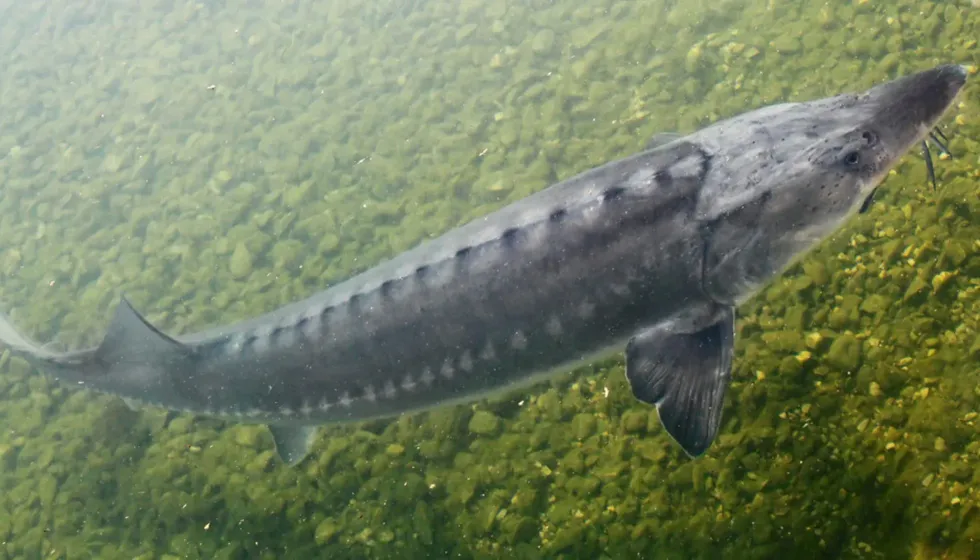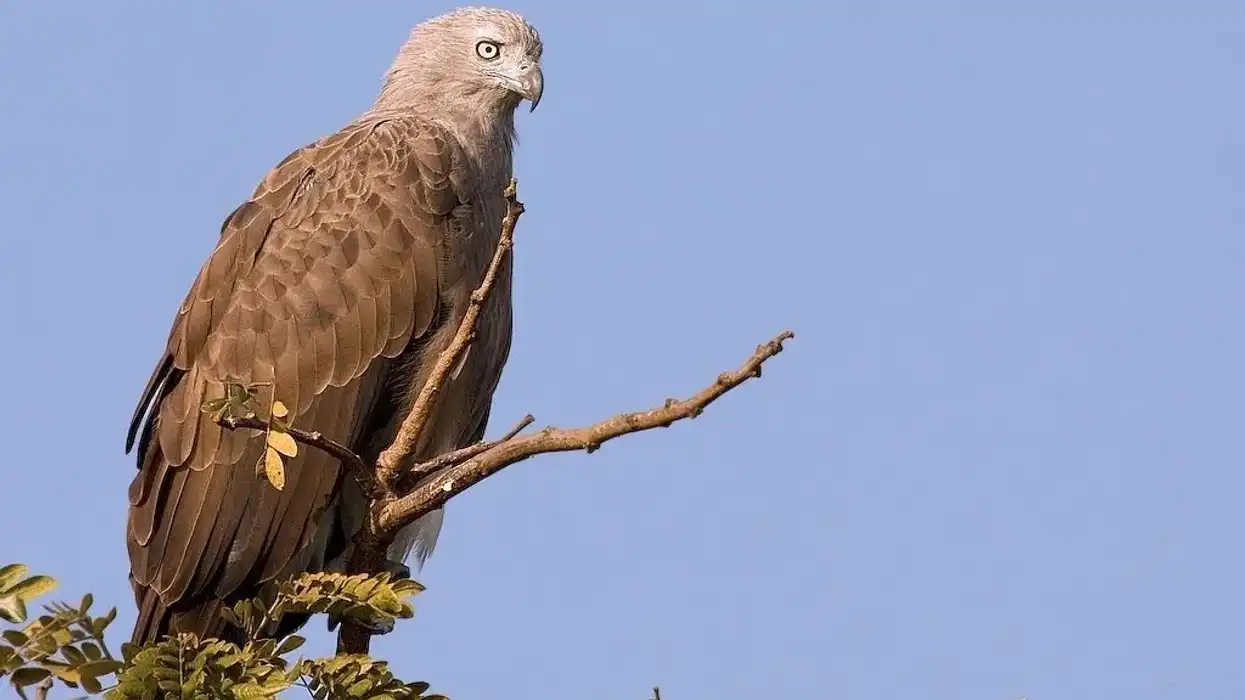The lake sturgeon belongs to the ray-finned fishes class from the sturgeons family. The scientific name of lake sturgeons is Acipenser fulvescens. It is a freshwater fish species found in the Great Lakes and in rivers such as the St. Lawrence River, Hudson Bay, and the Mississippi River in North America, Europe, and Asia.
The lake sturgeon has smooth and scaleless skin and is found in dark-brown or black colors. Sometimes, they are also spotted in olive green with dark black spots.
They are bony fish covered with more robust ganoid scales, and they generally spend their whole life in water, like most fish. Sturgeons do not have teeth; they catch their prey with the help of a suction-like mouth.
The lake sturgeon is a carnivore and feeds itself with marine food like aquatic macroinvertebrates, freshwater mussels, snails, crustaceans, and small fish.
The female sturgeon spawns once every four to nine years. Spawning occurs from April to June on the clean gravel shoals and stream rapids.
They require a moderate water temperature, usually between 55-64 F (12.7-337.7 C). The average litter size is 4000-7000 eggs, followed by an incubation period of eight to 14 days. Both parents take care of the eggs and keep them safe from predators.
Many wildlife reports list the lake sturgeon species as Threatened with a declining population. This sturgeon has to face many threats, including over-fishing.
If you liked reading about these facts about lake sturgeons, you could also check out some facts on the Pacific cod and giant trevally.
Lake Sturgeon Interesting Facts
What type of animal is the lake sturgeon?
Lake sturgeons are fish from the kingdom Animalia.
What class of animal does the lake sturgeon belong to?
Lake sturgeons are from the sturgeons family belong to the Actinopterygii class, also called ray-finned fishes. They originated from North America with the scientific name Acipenser fulvescens.
How many lake sturgeons are there in the world?
There are 18000-21000 lake sturgeons left in the world. There are 26 species of lake sturgeons with a declining population rate.
Where does a lake sturgeon live?
Lake sturgeons are found all over the world. They are commonly seen in the Great Lakes, Mississippi River, and Hudson Bay.
What is a lake sturgeon's habitat?
The lake sturgeon is a wildlife species found in the Mississippi River, Hudson Bay, and the Great Lakes. The lake sturgeon lives at a depth of around 16.5-29 ft (5-9 m) deep. They require a temperature of 76.82 or 64.58 F (24.9 or 18.1 C) for survival.
Who do lake sturgeons live with?
The lake sturgeon is one of many marine wildlife species with a solitary nature that prefers living alone in the river or in the Great Lakes.
How long does the lake sturgeon live?
A male lake sturgeon can live for 55 years and females can live for around 80-150 years. Lake sturgeons' populations are declining all over the world.
How do they reproduce?
The lake sturgeon species reaches sexual maturity at the age of 15-25 years old. Female sturgeons spawn once in four to seven years. Lake sturgeons migrate towards the shoreline.
Male sturgeons swim beside females and strenuously rub their tails to release sperm while female sturgeons release eggs to react. Sturgeons spawn once every four years.
After fertilization, the eggs hatch in five to eight days. These larvae then float back downstream for many weeks. As these larvae slowly develop tails, they prefer slower waterways and gradually mature over a dozen years.
What is their conservation status?
According to the U.S. Fish And Wildlife Service and the IUCN Red List, lake sturgeon populations are listed as Threatened. Some lake sturgeon subspecies are also categorized as Critically Endangered.
Lake Sturgeon Fun Facts
What do lake sturgeons look like?
Lake sturgeons look like an armored torpedo due to their velvety-shiny skin and rows of bony plates on their light-colored sides with their white belly. They usually spot dark-brown, black, or olive green colors with dark spots traditionally found in juveniles. Lake sturgeons don't usually have teeth and instead have a suction-like mouth to catch insects or other prey.
How cute are they?
The lake sturgeon is not considered a cute or colorful fish. They are plain fish with a bold nature.
How do they communicate?
Lake sturgeons live in rivers and communicate through tactile and chemical signals. Their communication duration is concise as they send short signals.
How big are lake sturgeons?
A lake sturgeon can grow up to 87 in (2.2 m) long. The lake sturgeon is six to seven times bigger than Paedocypris progenetica, the smallest freshwater fish.
How fast can the lake sturgeon swim?
The lake sturgeon is found in the Great Lakes or in a small river. No data is recorded regarding how fast they can swim, but what is known is that their swimming speed is categorized into three stages: sustained, prolonged, and burst.
How much does the lake sturgeon weigh?
The lake sturgeon weighs around 240 lb (108 kg).
What are their male and female names of the species?
Males are known as male lake sturgeons and females are known as female lake sturgeons.
What would you call a baby lake sturgeon?
There are no specified names for a baby lake sturgeon. They are generally known as juvenile lake sturgeons. Their eggs hatch in three to seven days, and then larvae hatch out of the eggs, which later grow into adults.
What do they eat?
Lake sturgeons are carnivores that prey on animal food. The diet of the sturgeon includes aquatic macroinvertebrates, mussels, snails, crustaceans, and small fish.
Are they dangerous?
Lake sturgeons are a fish species that is found in small rivers, ponds, and lakes. They are not intentionally harmful to humans until they sense danger or feel threatened.
Would they make a good pet?
No, it is not recommended to keep them as pets. Lake sturgeons are found in a small river or a lake and are to the temperature and environment of this habitat.
In many countries, fishing and catching these fish is illegal simply because of their Threatened status and the fact that they are even classified as Critically Endangered in some places.
Did you know...
Considering its history, the lake sturgeon is a long‐lived species. The first fish of the lake sturgeon (Acipenser fulvescens) species was found 200 million years ago. The oldest sturgeon was about 152 years old, weighing 310 lb (140 kg).
The beluga or European sturgeon is the largest freshwater fish in the world.
Why is the lake sturgeon endangered?
Between 2013 to 2015, there were only around 18000-21000 lake sturgeons left worldwide. The main causes of this diminishing population are over-fishing for food, poaching, pollution, and destruction of natural watercourses and habitats. Another reason is that the female lake sturgeon mates just once in four to seven years, leading to a very low reproduction rate.
Catching lake sturgeons
The typical lake sturgeon habitat refers to freshwater usually found in rivers, ponds, and lakes. They don't prefer living in muddy water.
Lake sturgeon fishing is illegal in many countries and lake sturgeon fishing is also very difficult. A sturdy rod with a heft line is recommended to catch this fish easily because it lets fishers pull in the fish fast. Fishers usually look in lakes, rivers, and ponds when fishing for lake sturgeons.
Here at Kidadl, we have carefully created lots of interesting family-friendly animal facts for everyone to discover! Learn more about some other fish from our pilchard facts and john dory facts pages.
You can even occupy yourself at home by coloring in one of our free printable lake sturgeon coloring pages.










